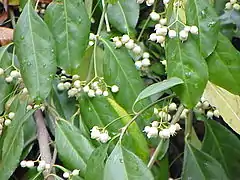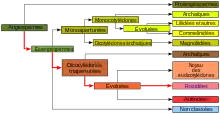Celastraceae
La famille des Celastraceae (Célastracées) regroupe des plantes dicotylédones. Selon Watson & Dallwitz elle comprend 850 espèces réparties entre 74 et 87 genres.

| Règne | Plantae |
|---|---|
| Sous-règne | Tracheobionta |
| Division | Magnoliophyta |
| Classe | Magnoliopsida |
| Sous-classe | Rosidae |
| Ordre | Celastrales |

Ce sont des arbres, des arbustes ou des lianes, des régions tempérées à tropicales. En France, c'est la famille du Fusain (Euonymus europaeus).
On peut citer aussi le genre Celastrus qui fournit de nombreuses espèces ornementales. Le khat, mastiqué dans la péninsule Arabique et la « Corne » de l'Afrique, est fourni par les feuilles fraîches de l'espèce Catha edulis
Étymologie
Le nom vient du genre type Celastrus dérivé du grec κηλάστρα / kêlastra (« houx, bidon »), nom donné par Théophraste ( - ], philosophe, botaniste et naturaliste grec, à un arbuste à feuillage persistant portant des fruits en hiver, probablement un houx Ilex[1].
Classification
La classification phylogénétique APG (1998)[2] et classification phylogénétique APG II (2003)[3] situent la divergence de cette famille à la base des Fabidées (Eurosids I). La famille est augmentée si l'on considère que toutes les Hippocratéacées lui appartiennent. Il faut y ajouter le genre Brexia issu de la famille des Brexiacées et les genres Acanthothamnus et Canotia issus des Canotiacées.
Sous-familles
- Celastroideae
- Hippocrateoideae
- Salacioideae
- Stackhousioideae
Liste des genres
La classification phylogénétique APG III (2009)[4] inclut dans cette famille les genres précédemment placés dans les familles Lepuropetalaceae, Parnassiaceae, Pottingeriaceae. Les genres Lepuropetalon, Parnassia et Pottingeria pour être précis.
Selon NCBI (4 mai 2010)[5] (Plus conforme à APGIII puisqu'il incorpore les genres Lepuropetalon, Parnassia et Pottingeria anciennement dans Lepuropetalaceae, Parnassiaceae, Pottingeriaceae) :
- Acanthothamnus (en)
- Allocassine (en)
- Apatophyllum (en)
- Brassiantha (en)
- Brexia (en)
- Campylostemon (en)
- Canotia (en)
- Cassine
- Catha (en)
- Celastrus
- Cheiloclinium (en)
- Crossopetalum (en)
- Cuervea (en)
- Denhamia (en)
- Dicarpellum (en)
- Elaeodendron
- Empleuridium (es)
- Euonymus
- Gloveria
- Gyminda
- Gymnosporia
- Hexaspora
- Hippocratea (en)
- Hylenaea
- Hypsophila
- Kokoona (en)
- Lauridia
- Lepuropetalon (en) (anciennement placé dans Lepuropetalaceae)
- Loeseneriella (en)
- Lophopetalum (en)
- Lydenburgia (en)
- Macgregoria
- Maurocenia (en)
- Maytenus
- Menepetalum (en)
- Monimopetalum
- Mortonia
- Moya
- Mystroxylon
- Orthosphenia
- Parnassia (anciennement placé dans Parnassiaceae)
- Paxistima (en)
- Peripterygia (en)
- Peritassa (en)
- Plagiopteron
- Pleurostylia
- Polycardia (en)
- Pottingeria (anciennement placé dans Pottingeriaceae)
- Prionostemma
- Pristimera
- Psammomoya
- Pseudosalacia (en)
- Pterocelastrus (en)
- Putterlickia (en)
- Quetzalia (en)
- Reissantia (en)
- Robsonodendron (en)
- Rzedowskia
- Salacia
- Salacighia
- Salaciopsis (en)
- Sarawakodendron (en)
- Schaefferia
- Semialarium
- Simicratea
- Siphonodon (en)
- Stackhousia
- Thyrsosalacia
- Tontelea
- Tricerma
- Tripterococcus
- Tripterygium
- Wimmeria (en)
- Zinowiewia (en)
Selon DELTA Angio (4 mai 2010)[6] :
- Allocassine
- Anthodon
- Apatophyllum
- Apodostigma
- Arnicratea
- Baequaertia
- Bhesa
- Brassiantha
- Brexiella
- Campylostemon
- Cassine
- Catha
- Celastrus
- Cheiloclinium
- Crossopetalum
- Cuervea
- Denhamia
- Dicarpellum
- Elachyptera
- Elaeodendron
- Empleuridium
- Euonymus
- Evonymopsis
- Fraunhofera
- Glyptopetalum (en)
- Goniodiscus
- Gyminda
- Hartogiella
- Hartogiopsis
- Hedraianthera
- Helictonema
- Herya
- Hexaspora
- Hippocratea
- Hylenaea
- Hypsophila
- Kokoona
- Loeseneriella
- Lophopetalum
- Maurocenia
- Maytenus
- Menepetalum
- Microtropis
- Monimopetalum
- Mortonia
- Moya
- Myginda
- Nicobariodendron (en)
- Orthodphenia
- Paxistima
- Peripterygia
- Peritassa
- Perottetia
- Platypterocarpus (en)
- Plenckia
- Pleurostylia
- Polycardia
- Pottingeria
- Prionostemma
- Pristimera
- Psammomoya
- Pseudosalacia
- Ptelidium
- Pterocelastrus
- Putterlickia
- Quetzalia
- Reissantia
- Rzedowskia
- Salacia
- Salacighia
- Salaciopsis
- Salvadoropsis
- Sarawakodendron
- Schaefferia
- Semialarium
- Simicratea
- Simirestis
- Tetrasiphon
- Thyrsosalacia
- Tontelea
- Torralbasia
- Tripterygium
- Tristemonanthus
- Viposia
- Wimmeria
- Xylonymus
- Zinowiewia
- Canotia Torr.
- Cassine L.
- Catha Forsskal ex Scop.
- Celastrus L.
- Crossopetalum P. Br.
- Euonymus L.
- Forsellesia
- Gyminda Sarg.
- Lophopyxis Hook.
- Maytenus Molina
- Mortonia Gray
- Paxistima Raf.
- Perrottetia Kunth
- Pristimera Miers
- Salacia L.
- Schaefferia
- Schaefferia Jacq.
- Torralbasia Krug & Urban
Genres comportant des espèces fossiles
Selon Paleobiology Database (site visité le 12 janvier 2023), la famille compte des espèces fossiles dans les genres suivants:
- Asterocelastrus
- Canticarpum
- Cathispermum
- Celastrinanthium
- Celastrinites
- Celastrinoxylon
- Celastrocarpus
- Celastrus
- Elaeodendron
- Elaeodendroxylon
- Euonymus
- Goupioxylon
- Gyminda
- Gymnosporioxylon
- Lophopetalumoxylon
- Maytenus
- Mystroxylon
- Pachystima
- Perrottetia
- Perrottetioxylon
Notes et références
- Acadpharm-Celastraceae
- (en) Angiosperm Phylogeny Group, « An ordinal classification for the families of flowering plants », Annals of the Missouri Botanical Garden, Jardin botanique du Missouri, vol. 85, no 4, , p. 531–553 (ISSN 0026-6493, 2162-4372, 0893-3243 et 2326-487X, DOI 10.2307/2992015, JSTOR 2992015, lire en ligne)
- (en) Angiosperm Phylogeny Group, « An update of the Angiosperm Phylogeny Group classification for the orders and families of flowering plants: APG II », Botanical Journal of the Linnean Society, Wiley-Blackwell, Linnean Society of London et OUP, vol. 141, no 4, , p. 399–436 (ISSN 0024-4074 et 1095-8339, DOI 10.1046/J.1095-8339.2003.T01-1-00158.X)
- (en) Angiosperm Phylogeny Group, « An update of the Angiosperm Phylogeny Group classification for the orders and families of flowering plants: APG III », Botanical Journal of the Linnean Society, Wiley-Blackwell, Linnean Society of London et OUP, vol. 161, no 2, , p. 105–121 (ISSN 0024-4074 et 1095-8339, DOI 10.1111/J.1095-8339.2009.00996.X)
- NCBI, consulté le 4 mai 2010
- DELTA Angio, consulté le 4 mai 2010
- Integrated Taxonomic Information System (ITIS), www.itis.gov, CC0 https://doi.org/10.5066/F7KH0KBK, consulté le 4 mai 2010
Voir aussi
Article connexe
Liens externes
- (fr) Référence Belles fleurs de France : Celastraceae
- (en) Référence Flora of China : Celastraceae
- (en) Référence Madagascar Catalogue : Celastraceae
- (en) Référence Flora of Chile : Celastraceae
- (en) Référence Angiosperm Phylogeny Website : Celastraceae ()
- (en) Référence Jardin botanique du Missouri : Celastraceae (images de Madagascar)
- (en) Référence DELTA Angio : Celastraceae R. Br.
- Voir aussi Canotiaceae, Goupiaceae, Lophopyxidaceae, Siphonodontaceae
- (en) Référence Tree of Life Web Project : Celastraceae
- (en) Référence Catalogue of Life : Celastraceae R. Br. (consulté le )
- (fr) Référence Tela Botanica (France métro) : Celastraceae
- (en) Référence Paleobiology Database : Celastraceae Brown
- (fr+en) Référence ITIS : Celastraceae
- (en) Référence NCBI : Celastraceae (taxons inclus)
- (en) Référence GRIN : famille Celastraceae R. Br. (+liste des genres contenant des synonymes)
- (en) Référence FloraBase (Australie-Occidentale) : classification Celastraceae